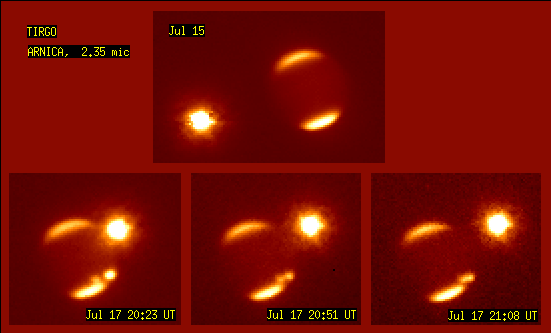

We observed Jupiter from 20:20 UT to 21:10 on the 17 of July with the IR Arcetri NIR NICMOS3 camera (ARNICA) through methane (2.35 micron) and continuum filters (1.58 micron) at the italian TIRGO telescope.
Two bright spots are clearly visible in the methane images; the spots are located close to the southern polar cap (at about the longitude of the SL9 impact zones), on the west side. The brighter one is at the west limb while the weaker one is at about 40-60 degrees from the limb. During the observations the intensity of the brighter spot decreases as it crosses the limb of the planet. The other spot moves across the disk of Jupiter because of the rotation of the planet.
These spots can be two of the three associated with the event E, as observed at the SAAO observatory.
The top image shows Jupiter on the 15th of July, before any impact, while the bottom images were taken 5 hours after the impact of fragment E on the 17th of July. North is up, east on the left.
The observations were made in the near-infrared at 2.35 micron, wavelength corresponding to a strong methane absorption band of the atmosphere of Jupiter. At this wavelength Jupiter is very faint and only auroral emission from the polar caps is visible.
In the bottom images, two bright spots produced by the impacts are clearly visible near the southern cap. The brighter spot has been originated by the impact of fragment E, about 5 hours before, while the fainter one has been originated probably by a previous impact.
Also visible in the two images are the satellites of Jupiter, the closest to the planet being Io.
Gian Paolo Tozzi - Osservatorio Astrofisico di Arcetri - Firenze (I) Ruggero Stanga - Dip. di Astronomia dell'Universita' - Firenze (I) Filippo Mannucci - Osservatorio Astrofisico di Arcetri - Firenze (I)